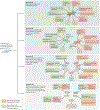Clinical and therapeutic relevance of cancer-associated fibroblasts
- PMID: 34489603
- PMCID: PMC8791784
- DOI: 10.1038/s41571-021-00546-5
Clinical and therapeutic relevance of cancer-associated fibroblasts
Abstract
Cancer-associated fibroblasts (CAFs) found in primary and metastatic tumours are highly versatile, plastic and resilient cells that are actively involved in cancer progression through complex interactions with other cell types in the tumour microenvironment. As well as generating extracellular matrix components that contribute to the structure and function of the tumour stroma, CAFs undergo epigenetic changes to produce secreted factors, exosomes and metabolites that influence tumour angiogenesis, immunology and metabolism. Because of their putative pro-oncogenic functions, CAFs have long been considered an attractive therapeutic target; however, clinical trials of treatment strategies targeting CAFs have mostly ended in failure and, in some cases, accelerated cancer progression and resulted in inferior survival outcomes. Importantly, CAFs are heterogeneous cells and their characteristics and interactions with other cell types might change dynamically as cancers evolve. Studies involving single-cell RNA sequencing and novel mouse models have increased our understanding of CAF diversity, although the context-dependent roles of different CAF populations and their interchangeable plasticity remain largely unknown. Comprehensive characterization of the tumour-promoting and tumour-restraining activities of CAF subtypes, including how these complex bimodal functions evolve and are subjugated by neoplastic cells during cancer progression, might facilitate the development of novel diagnostic and therapeutic approaches. In this Review, the clinical relevance of CAFs is summarized with an emphasis on their value as prognosis factors and therapeutic targets.
© 2021. Springer Nature Limited.
Conflict of interest statement
Competing interests
The authors declare no competing interests.
Figures




References
-
- Hanahan D & Coussens LM Accessories to the crime: functions of cells recruited to the tumor microenvironment. Cancer Cell 21, 309–322 (2012). - PubMed
-
- Hanahan D & Weinberg RA Hallmarks of cancer: the next generation. Cell 144, 646–674 (2011). - PubMed
-
- Kalluri R Basement membranes: structure, assembly and role in tumour angiogenesis. Nat. Rev. Cancer 3, 422–433 (2003). - PubMed
-
- Madhavan S & Nagarajan S GRP78 and next generation cancer hallmarks: an underexplored molecular target in cancer chemoprevention research. Biochimie 175, 69–76 (2020). - PubMed
-
- Pietras K & Ostman A Hallmarks of cancer: interactions with the tumor stroma. Exp. Cell Res 316, 1324–1331 (2010). - PubMed
Publication types
MeSH terms
Grants and funding
LinkOut - more resources
Full Text Sources
Other Literature Sources
Medical
Research Materials

